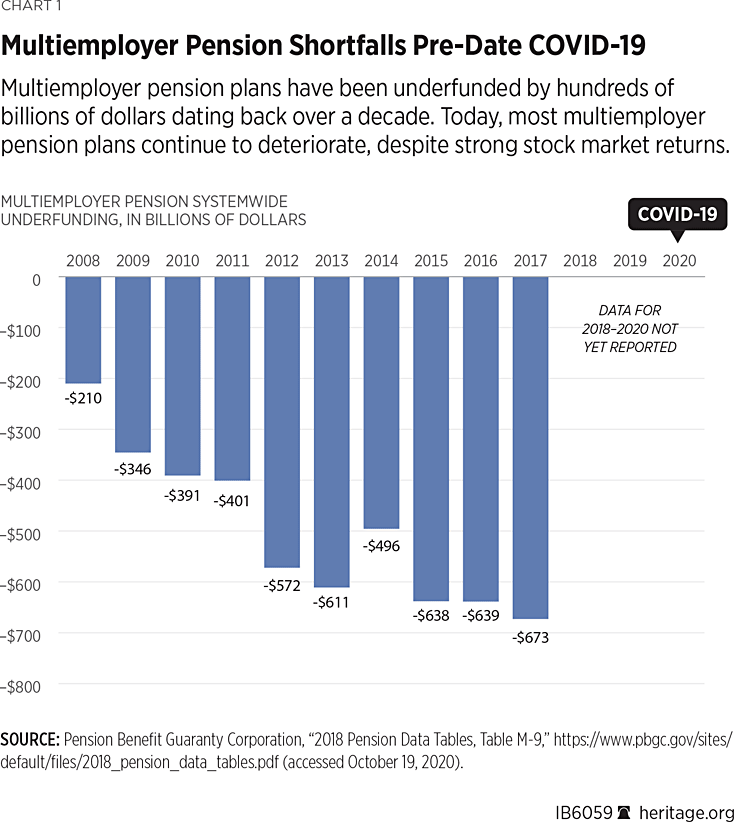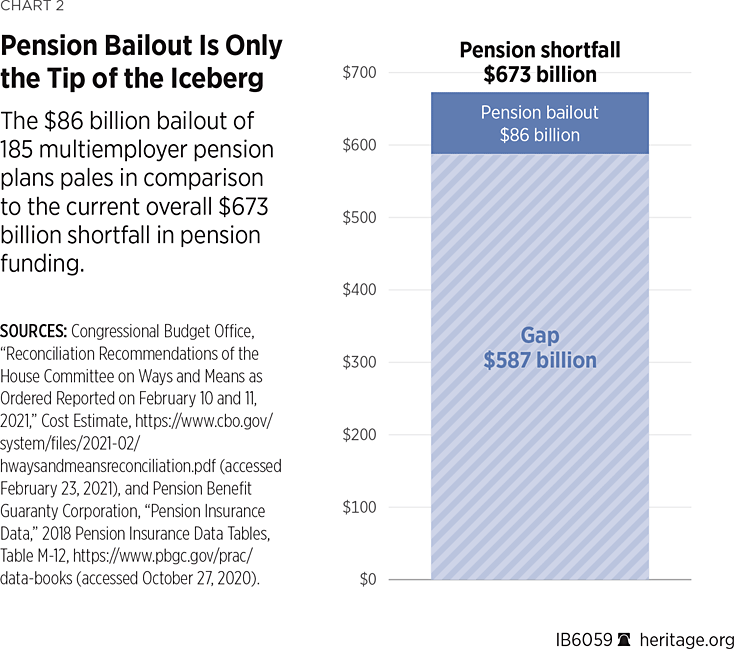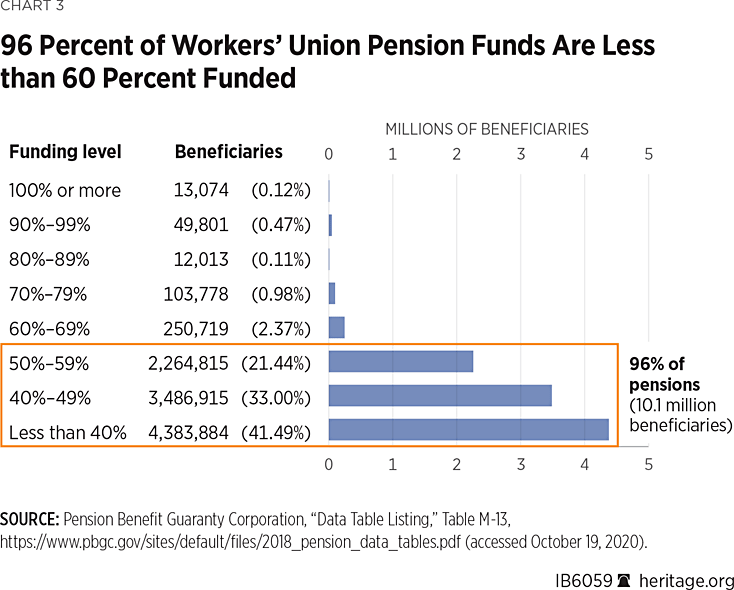Across the United States, 10.8 million workers and retirees belong to about 1,400 multiemployer (union) pension plans.REF These plans are massively underfunded—having promised $673 billion more in pension benefits than they have set aside to pay, and now Congress is poised to hand a select group of these plans at least $86 billion in unconditional taxpayer bailouts.
Succumbing to the pressure of unions that failed—often recklessly—to deliver the secure retirements they promised their dues-paying members, lawmakers have included this pension bailout in the so-called COVID-19 relief package.
Yet these broken pension promises started many decades before COVID-19, and multiple pension-bailout proposals have been introduced, without success, in recent Congresses. The most recently available data showing a $673 billion funding shortfall is based on pensions’ 2017 financial reports.REF Since then, the S&P 500 has increased by more than 50 percent. Yet, most multiemployer pension plans are not only in a deep hole, but still digging deeper because the multiemployer pension structure is so desperately flawed and abused.


Congress needs to fix the broken multiemployer pension system so that private unions and private employers cannot make promises and then fail to keep them with little accountability. The pension provisions in the $1.9 trillion partisan COVID-19 package do nothing to fix multiemployer pensions’ promises, and instead make it easier for multiemployer plans to make even more broken promises without consequences. Moreover, the provisions extend some of the broken components of multiemployer pensions to single-employer pensions which—because of their appropriate rules—are well-funded and not seeking taxpayer bailouts.
The main components of the proposed bailout include:
1. At Least $86 Billion in Unconditional Taxpayer Bailouts to Select Multiemployer Pensions. Plans whose financial status is considered “critical and declining,” or in some instances, “critical” can apply to receive lump sum cash transfers in amounts sufficient to pay 100 percent of their pension benefits and plan expenses (which includes paying union trustees’ who manage the plans) through 2051, at which point, most of those plans would likely go from paying 100 percent benefits to being insolvent. The legislation calls the cash transfers “special financial assistance,” but as the Congressional Budget Office (CBO) noted, “[t]hose grants would come from Treasury’s general fund.”REF
In addition to giving taxpayer dollars to plans in declining financial status, the proposal would retroactively allow plans that are on the path to improved solvency—by implementing partial benefit reductions as provided through bipartisan legislation signed into law by President Barack Obama in 2014—to also receive taxpayer dollars to reinstate full pension benefits.
The CBO estimated that 185 plans—about 13 percent of private union pension plans—would receive taxpayer funds, but it noted that “there is uncertainty about both the number of pension plans that would qualify for grants and about the amount that each plan would receive.”REF In particular, the legislation allows plans to use lower interest rate assumptions in order to qualify for assistance.REF The CBO noted that its simulations included 336 plans potentially qualifying for taxpayer dollars.
Regardless of whether the private union pension tab forced on taxpayers is $86 billion or much larger, this bailout would not come close to making plans solvent. According to the Pension Benefit Guaranty Corporation (PBGC), the 50 plans with the highest levels of underfunding have $372 billion in combined underfunding, with total underfunding amounting to $673 billion.REF The proposed $86 billion would be just a partial stop-gap until 2052, at which point most plans that received taxpayer bailouts will still fail, leaving current workers who will be retired in 2052 and beyond with pennies on the dollar in promised pension benefits.
Moreover, this bailout only covers the tip of the union pension iceberg as 96 percent of all workers with multiemployer pension plans have plans that are less than 60 percent funded, and 75 percent have plans that are less than 50 percent funded.REF It is only a matter of time before virtually all union pension plans fail and this bill—needing to conform to the limits of the reconciliation process necessary to pass this partisan package—only modestly kicks the can down the road with selective bailouts. In an analysis of a prior version of this union pension bailout, the CBO concluded that once taxpayer dollars dry up, the overwhelming majority of plans would still become insolvent.REF

2. Papering Over of Current Single-Employer Pension Shortfalls. In general, single-employer pension plans (private pensions operated by a single company instead of a union) are well governed and well funded. If plans have shortfalls—such as from failing to make adequate contributions in the past, or not achieving their assumed rates of return—they are required to make up for those shortfalls by increasing contributions over a period of time (currently seven years). This important requirement protects workers from losing promised pension benefits. The proposal, however, would allow plans that have shortfalls to set them equal to zero—wiping away their liabilities for the purpose of having to actually make good on their promises and thus hurting future retirees.
This is effectively like telling consumers with large debts that they can set them equal to zero for purposes of planning their budgets, but all the while, those debts are still accumulating with interest. In the end, whether employers recognize them or not, the shortfalls will still be there—and they will have grown larger.
The proposal also allows single-employer plans to make up, or repay, future funding shortfalls over a period of 15 years, instead of the current seven years.
3. Special Treatment for Community Newspaper Plans. The single biggest reason that multiemployer pension plans are underfunded is that they have consistently used high interest rate assumptions—in the range of 7 percent to 8 percent—as a way to reduce their required contributions. Now at the same time that lawmakers supporting these provisions want to bail out multiemployer plans for the consequences of using excessively high interest rate assumptions, they also want to allow community newspaper plans to use those same 8 percent assumptions, while also giving community newspapers at least twice as long—30 years—to make up for past shortfalls.
This is equivalent to allowing employers to borrow against their workers’ 401(k) plans, and if the company fails, it is the workers who lose out on their planned retirement benefits. All employers—whether single-employers or part of multiemployer pensions, and whether community newspapers or community utility providers—should have to use the same, appropriate interest rate assumptions and underfunding repayment periods necessary to ensure the security of their workers’ promised pensions.
Virtually everything about this pension bailout bill goes in the wrong direction, causing plans to become more underfunded instead of improving their finances.REF As the CBO noted, “All three provisions would reduce required employer contributions,” which “would result in greater shortfalls and higher variable-rate premiums.”REF Ironically, these ill-effects for workers and employers boost the federal government’s ledgers through higher tax revenues and increased PBGC premiums, reducing the outward appearance of the magnitude of the bailout by $12.6 billion.REF
Meanwhile, by providing cash bailouts to a limited number of plans, this proposal opens the door to upwards of $673 billion in future private union pension bailouts, as well as $4 trillionREF to $5 trillionREF in public-sector state and local pension bailouts. All told, every American household could be on the hook for more than $45,000 in unfunded liabilities for other people’s pensions, even as they try to save for their own retirements.
Pensions are part of workers’ compensation, and employers and unions should not be allowed to make promises they cannot keep. This requires fixing the rules instead of bailing out reckless actions without consequences for plans and without recourse for taxpayers. While there is no way to undo $673 billion of failing pension promises, there are ways to minimize pension losses while also protecting taxpayers and fixing the system for current and future workers and retirees. I have previously proposed 12 reforms to comprehensively address the broken multiemployer pension system, to ensure the PBGC’s solvency, and to protect taxpayers and pensioners.REF This problem is decades in the making and a “simple” taxpayer bailout under the guise of “COVID-19 relief” is both inappropriate and inadequate.
As Maya McGuiness of the nonpartisan Committee for a Responsible Federal Budget aptly stated, “These multiemployer pensions have been on shaky ground for some time and ought to be dealt with transparently, where lawmakers can appropriately finance and reform these plans…[not] in a piece of crisis legislation.” She added: “Frankly, no member of Congress should be willing to defend this.”REF
Conclusion
If lawmakers insist on using taxpayer dollars to prop up private union pension plans, those bailouts must come with strings attached. Any private pension plan receiving taxpayer dollars should be immediately frozen and unable to make any new pension promises until the plan can, of its own accord, make good on all current and potential future promises (using appropriate discount rate assumptions).
Any plan receiving taxpayer dollars should not be allowed to increase any pension benefits, nor to reduce pension contributions, and should have to transition to abiding by the same set of funding rules required of single-employer pension plans. Moreover, policymakers should include provisions to allow the PBGC greater oversight of plans receiving taxpayer funding, including the authority to take over failed plans—as it does for single-employer plans—and to reduce benefits to PBGC-insured levels so that younger workers in plans receiving taxpayer bailouts are not left with mere pennies on the dollar in order to preserve 100 percent of current retirees’ and older workers’ benefits.
There is a better way than selective and unconditional bailouts under the guise of COVID-19 relief to fix the broken multiemployer pension system—one that will not pick winners and losers among different pension plans, one that will not strip younger workers of their hard-earned pension contributions, and one that will not force taxpayers to pay for the broken promises of private-sector employers and unions.
Rachel Greszler is Research Fellow in Economics, the Budget, and Entitlements in the Grover M. Hermann Center for the Federal Budget, of the Institute for Economic Freedom, at The Heritage Foundation.



